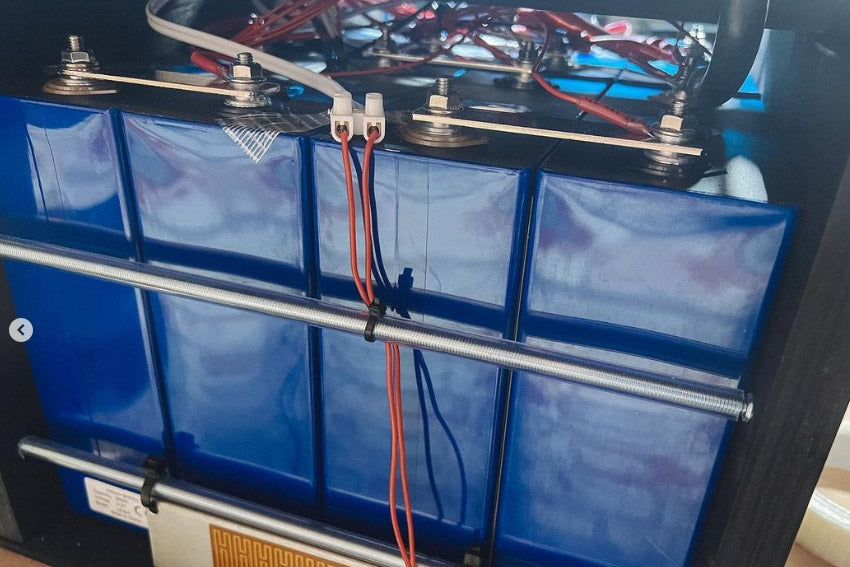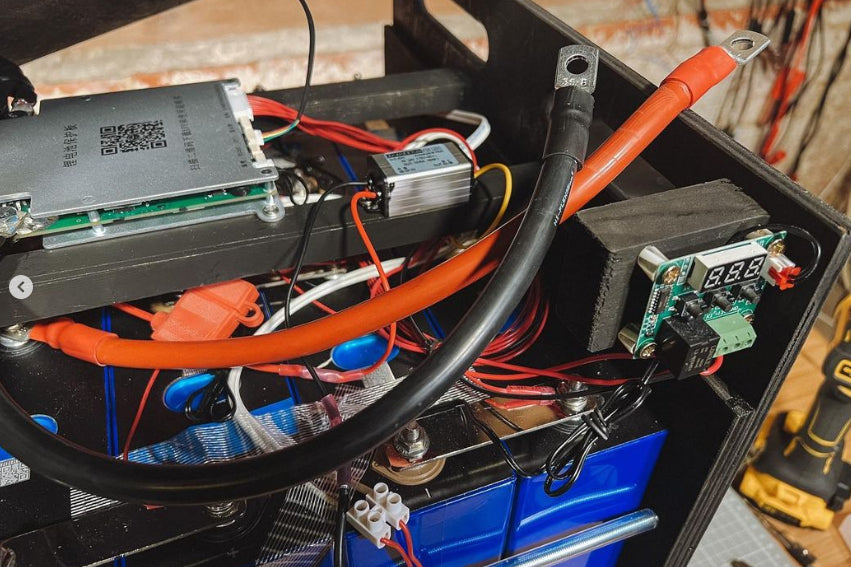Diypow marine lithium batteries offer fast charging and high discharge performance.
Compared with the conventional lead-acid batteries in the past, the charging time of our lithium batteries is greatly reduced by 88.7%. The charging speed of lead-acid battery is only 0.1C, but the charging speed of Li-ion battery can reach 1C. Of course, we do not recommend charging too fast to prolong the cycle life of Li-ion battery. High discharge is the most outstanding advantage of drive motor. Our lithium deep cycle marine battery can provide high current discharge, which can start the motor and drive in a period of time. The high discharge performance determines that our LiPo batteries can drive most loads.
Choosing Diypow lithium batteries means choosing peace of mind. You can concentrate on every fishing trip, you can enjoy every ocean voyage and forget about the hassle of battery replacement. Our lithium batteries are designed to solve your problems.
Diypow 12V 50AH Drop-In SLA Replacement Deep Cycle LiFePO4 Battery Pack
Diypow 12V 100AH Deep Cycle LiFePO4 Battery Pack | 1.28kWh & 1.28kW
Diypow 12V 200AH Deep Cycle LiFePO4 Battery Pack | 2.56kWh & 1.28kW
Diypow 36V 60AH Drop-In SLA Replacement Deep Cycle LiFePO4 Battery Pack
Diypow 36V 120AH Drop-In SLA Replacement Deep Cycle LiFePO4 Battery Pack
Diypow 48V 30AH Drop-In SLA Replacement Deep Cycle LiFePO4 Battery Pack
Diypow Best Lithium Marine Batteries
For those who love sea fishing, there is nothing more enchanting than a full day's fishing trip in the open sea. However, a trawler or fishing boat with insufficient power is often a bottleneck in fishing activities, which not only limits their range of action but also makes them miss out on the opportunity to catch more fish.
This is where the Diypow marine lithium battery comes in. Our batteries use advanced technology to provide long-term high-power discharge, ensuring your boat travels further distances and finds more fish. What's more, our professional fishfinder lithium batteries provide continuous power, so you don't have to worry about running out of power and can devote yourself to the fun of fishing.
In addition, the backup time of Diypow's marine lithium batteries is a major advantage. With just two batteries, you can enjoy up to 10 hours of standby time, equipping your boat with more appliances, lights and entertainment equipment to make life on the water more convenient and comfortable. Best of all, we also offer professional marine batteries to ensure you have uninterrupted contact with your family and are safe at sea. when you want to add more batteries to your electric boat to drive loads, be sure to consider the Diypow marine lithium battery.
More Application Scenarios
Types of Lithium Marine Batteries and Their Purpose
⚡CRANKING BATTERIES
⚡DEEP CYCLE BATTERIES
⚡DUAL PURPOSE BATTERIES
The 4 Boat Battery Technology Types
⚡LEAD-ACID BATTERIES
⚡AGM BATTERIES
⚡GEL BATTERIES
⚡LITHIUM BATTERIES
Diypow Lithium Marine Batteries
⭐Consistent Output
⭐Long Lasting
⭐1/3 Lighter Than Lead Acid Battery
⭐6 Strong Protections
⭐Fast Charge
⭐Higher Discharge Rate
Hot Products
Diypow 48V 100AH Drop-In SLA Replacement Deep Cycle LiFePO4 Battery Pack
Diypow 48V 30AH Drop-In SLA Replacement Deep Cycle LiFePO4 Battery Pack
Diypow 48V 120AH Drop-In SLA Replacement Deep Cycle LiFePO4 Battery Pack
Diypow 12V 50AH Drop-In SLA Replacement Deep Cycle LiFePO4 Battery Pack
Marine Lithium Battery for Boats Buying Guide
Marine lithium batteries are specifically designed for boat use. Most batteries will make your boat heavy and difficult to move if maintenance is required. Ionic deep-cycle lithium marine batteries are light weight and compact enough to fit in almost any boat and won't weigh your boat down.
With ion lithium marine batteries, you will need to pay more up front, but in the long run, these costs will save you a lot. A 12v deep cycle lithium battery will last longer and be more reliable than a car battery on a boat.
- 12-volt lithium marine battery
- 24-volt lithium marine battery
- 36-volt lithium marine battery
This purchase covers the different features you need to know before making a buying decision. Let us know more about this:
1. What are lithium marine batteries?
Marine batteries are designed specifically for use on a boat, with heavier plates and robust construction designed to withstand the vibration and pounding that can occur onboard any powerboat.
2. Can I use a lifepo4 as a marine starting battery for my boat?
Yes, if you are looking for the best marine battery, this is an easy choice. Lithium-ion marine batteries are completely responsible for starting your outboard, powering your trolling motor and powering your electronics.
3. Can I put a lithium battery in my boat?
It is worth noting that the only lithium-ion battery chemical currently recommended for safe use on board is lithium iron phosphate (LiFePO4), commonly abbreviated as LFP.
4. Are lithium marine batteries worth it?
Why is lithium a better choice for the Marine Corps? There are several factors that make lithium the best choice for marine applications. Diypow lithium marine batteries are lighter, more efficient and have a longer life than traditional lead-acid deep-cycle batteries.
5. What is the problem with lithium batteries in boats?
Any lithium-ion battery chemical has the potential to cause thermal runaway, which means they are not plug-and-play when installed in a boat. Of course, Diypow marine batteries are fast to charge and you can pre-charge them.
6. Do lithium marine batteries need a special charger?
If a lead-acid charger reaches a voltage level that a lithium battery can't handle, it can cause permanent damage to the battery. We always recommend using a lithium battery charger, not only because it is safer, but because it helps the battery charge faster.
7. Will my boat motor charge a lithium battery?
In general, most modern marine engines have a built-in alternator that is designed to charge the batteries on board while the engine is running. However, not all alternators are compatible with lithium batteries, which require specific charging configurations to ensure their longevity and safety.
8. Can a lithium battery start an outboard?
This is why so many people appreciate marine lithium-ion batteries these days. If you are looking for the best marine battery, Diypow is an easy choice. Lithium-ion marine batteries are completely responsible for starting your outboard, powering your trolling motor, and powering your electronics.
9. How long do lithium marine batteries last?
Lithium marine batteries will typically last 3,000-5,000 charge cycles. This usually translates to lithium batteries lasting ten years or longer.
10. Can I leave my lithium batteries in my boat over the winter?
Technically, it is permissible to leave batteries on board during very cold winter months. This is because Diypow marine batteries have low-temperature protection. However, due to potential damage or additional maintenance, it is generally not recommended to use.
11. What happens when you charge a lithium-ion battery with a regular charger?
Battery life can be greatly reduced due to periodic overvoltage charging or irreversible damage to the battery. Many lead-acid chargers equalize as an automatic phase that cannot be turned off.
12. Should you leave a lithium battery on charge all the time?
If you do fill your battery all the way up, don't leave the device plugged in. Instead, follow the shallow discharge and recharge cycle we just mentioned. This isn't a safety issue: Lithium-ion batteries have built-in safeguards designed to stop them from exploding if they're left charging while at maximum capacity.
13. Do lithium batteries work well in cold weather?
While no battery can perform perfectly in cold weather, lithium batteries perform much better than lead acid and other batteries. Diypow marine batteries can be charged and discharged properly in cold temperatures, making them very cost-effective.
14. How often should you charge lithium batteries when not in use?
Before storing the battery, charge or discharge the battery to about 50% of capacity. Charge the battery at least once every six months to approximately 50% of capacity. Remove the battery and store it separately from the product. Store the batteries at 5 to 20 degrees Celsius (41 to 68 degrees Fahrenheit).
15. How many times can a marine battery be recharged?
Used correctly, deep cycle batteries can provide 3000 to 5000+ discharge/charge cycles. Starter batteries are not designed for continuous discharge and will only last 50 to 60 cycles of use.














